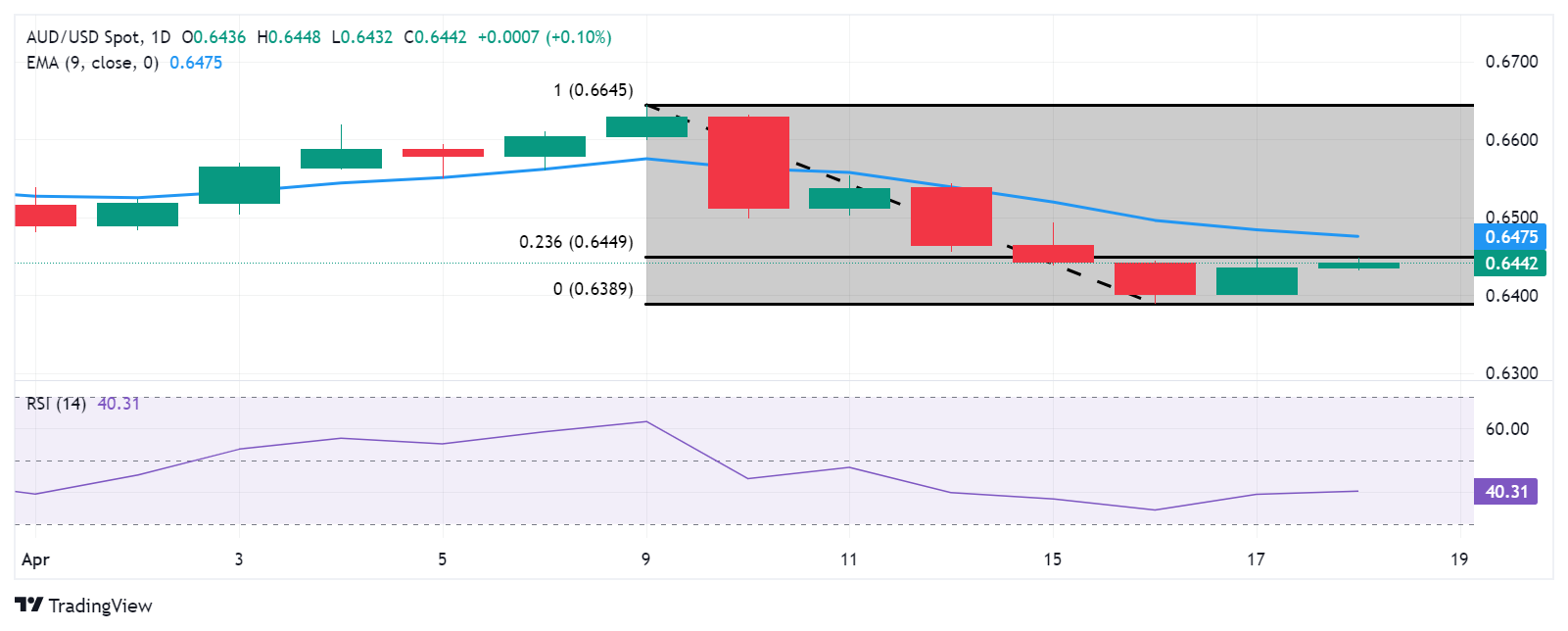- Australian Dollar appreciates as the ASX 200 Index continues to gain ground on Thursday.
- Australia’s Employment Change came in at -6.6K and the Unemployment Rate increased by 3.8% in March.
- US President Joe Biden calls for tripling the existing 7.5% tariff rate on Chinese steel and aluminum.
- The decline in the US Treasury yields exerts pressure on the US Dollar.
The Australian Dollar (AUD) continues to gain ground for the second consecutive day on Thursday. The decline in the US Dollar (USD) contributes support for the AUD/USD pair. However, the mixed Australian employment data appear to exert downward pressure on the AUD.
The Australian Dollar gains momentum as the ASX 200 Index continues to climb on Thursday. The domestic equity market is bolstered by gains in mining stocks, supported by firmer metals prices. Additionally, according to a Westpac report, while the Reserve Bank of Australia (RBA) has indicated that rates are unlikely to be raised further, it requires greater confidence in the inflation outlook before contemplating the possibility of rate cuts.
The US Dollar Index (DXY) loses ground, primarily influenced by subdued US Treasury yields. This correction in the US Dollar is further reinforced by renewed selling pressure and an overall risk-on sentiment in the market. Investors watch for the release of weekly Initial Jobless Claims and Existing Home Sales later on Thursday, which could provide further insight into the state of the US economy and potentially impact the direction of the US Dollar.
Daily Digest Market Movers: Australian Dollar extends gains amid mixed labor data
- Australia’s Employment Change posted a reading of -6.6K for March, against the expected 7.2K and 117.6K prior.
- Australia’s Unemployment Rate rose to 3.8% in March, lower than the expected 3.9% but higher than the previous reading of 3.7%.
- US President Joe Biden spoke at the heart of the American steel industry in Pittsburgh on Wednesday, emphasizing the need for increased pressure on the Chinese steel sector. He has directed US Trade Representative Katherine Tai to consider tripling the current 7.5% tariff rate on Chinese steel and aluminum, as reported by CBS News.
- Federal Reserve Bank of Cleveland President Loretta Mester, speaking on Wednesday, acknowledged that inflation has exceeded expectations, and the Fed needs further assurance before confirming the sustainability of 2% inflation. She also stated that monetary policy is well-positioned, with the possibility of a rate cut if labor market conditions worsen.
- Fed Governor Michelle Bowman commented on Wednesday that progress in inflation is slowing, with a potential stall. Bowman also noted that monetary policy is currently restrictive, and its sufficiency will be determined over time.
- The Federal Reserve's Beige Book survey of regional business contacts indicates that the US economy has "expanded slightly" since late February. Furthermore, firms reported facing increased challenges in passing on higher costs.
Technical Analysis: Australian Dollar hovers around the major level of 0.6450
The Australian Dollar traded around 0.6440 on Thursday. The 14-day Relative Strength Index (RSI) suggests a bearish sentiment for the AUD/USD pair as it remains below the 50 level. Key resistance for the pair is anticipated at the 23.6% Fibonacci retracement level of 0.6449, coinciding with the significant level of 0.6450. A breach above this level could strengthen the pair's momentum, potentially testing the nine-day Exponential Moving Average (EMA) at 0.6475, followed by the psychological barrier of 0.6500. On the downside, notable support is identified at the psychological level of 0.6400. A breach below this level might increase downward pressure on the AUD/USD pair, potentially leading it towards the major support level at 0.6350.
AUD/USD: Daily Chart
Australian Dollar price today
The table below shows the percentage change of Australian Dollar (AUD) against listed major currencies today. Australian Dollar was the strongest against the US Dollar.
| USD | EUR | GBP | CAD | AUD | JPY | NZD | CHF | |
| USD | -0.15% | -0.17% | -0.18% | -0.20% | -0.05% | -0.27% | -0.12% | |
| EUR | 0.16% | 0.00% | -0.01% | -0.05% | 0.12% | -0.10% | 0.01% | |
| GBP | 0.17% | 0.01% | -0.01% | -0.03% | 0.13% | -0.11% | 0.03% | |
| CAD | 0.18% | 0.03% | 0.01% | -0.02% | 0.13% | -0.09% | 0.04% | |
| AUD | 0.19% | 0.03% | 0.02% | 0.01% | 0.15% | -0.08% | 0.05% | |
| JPY | 0.05% | -0.12% | -0.13% | -0.16% | -0.15% | -0.22% | -0.10% | |
| NZD | 0.27% | 0.12% | 0.11% | 0.09% | 0.07% | 0.22% | 0.13% | |
| CHF | 0.15% | 0.00% | -0.03% | -0.05% | -0.07% | 0.11% | -0.14% |
The heat map shows percentage changes of major currencies against each other. The base currency is picked from the left column, while the quote currency is picked from the top row. For example, if you pick the Euro from the left column and move along the horizontal line to the Japanese Yen, the percentage change displayed in the box will represent EUR (base)/JPY (quote).
Australian Dollar FAQs
One of the most significant factors for the Australian Dollar (AUD) is the level of interest rates set by the Reserve Bank of Australia (RBA). Because Australia is a resource-rich country another key driver is the price of its biggest export, Iron Ore. The health of the Chinese economy, its largest trading partner, is a factor, as well as inflation in Australia, its growth rate, and Trade Balance. Market sentiment – whether investors are taking on more risky assets (risk-on) or seeking safe havens (risk-off) – is also a factor, with risk-on positive for AUD.
The Reserve Bank of Australia (RBA) influences the Australian Dollar (AUD) by setting the level of interest rates that Australian banks can lend to each other. This influences the level of interest rates in the economy as a whole. The main goal of the RBA is to maintain a stable inflation rate of 2-3% by adjusting interest rates up or down. Relatively high interest rates compared to other major central banks support the AUD, and the opposite for relatively low. The RBA can also use quantitative easing and tightening to influence credit conditions, with the former AUD-negative and the latter AUD-positive.
China is Australia’s largest trading partner so the health of the Chinese economy is a major influence on the value of the Australian Dollar (AUD). When the Chinese economy is doing well it purchases more raw materials, goods and services from Australia, lifting demand for the AUD, and pushing up its value. The opposite is the case when the Chinese economy is not growing as fast as expected. Positive or negative surprises in Chinese growth data, therefore, often have a direct impact on the Australian Dollar and its pairs.
Iron Ore is Australia’s largest export, accounting for $118 billion a year according to data from 2021, with China as its primary destination. The price of Iron Ore, therefore, can be a driver of the Australian Dollar. Generally, if the price of Iron Ore rises, AUD also goes up, as aggregate demand for the currency increases. The opposite is the case if the price of Iron Ore falls. Higher Iron Ore prices also tend to result in a greater likelihood of a positive Trade Balance for Australia, which is also positive of the AUD.
The Trade Balance, which is the difference between what a country earns from its exports versus what it pays for its imports, is another factor that can influence the value of the Australian Dollar. If Australia produces highly sought after exports, then its currency will gain in value purely from the surplus demand created from foreign buyers seeking to purchase its exports versus what it spends to purchase imports. Therefore, a positive net Trade Balance strengthens the AUD, with the opposite effect if the Trade Balance is negative.
Information on these pages contains forward-looking statements that involve risks and uncertainties. Markets and instruments profiled on this page are for informational purposes only and should not in any way come across as a recommendation to buy or sell in these assets. You should do your own thorough research before making any investment decisions. FXStreet does not in any way guarantee that this information is free from mistakes, errors, or material misstatements. It also does not guarantee that this information is of a timely nature. Investing in Open Markets involves a great deal of risk, including the loss of all or a portion of your investment, as well as emotional distress. All risks, losses and costs associated with investing, including total loss of principal, are your responsibility. The views and opinions expressed in this article are those of the authors and do not necessarily reflect the official policy or position of FXStreet nor its advertisers. The author will not be held responsible for information that is found at the end of links posted on this page.
If not otherwise explicitly mentioned in the body of the article, at the time of writing, the author has no position in any stock mentioned in this article and no business relationship with any company mentioned. The author has not received compensation for writing this article, other than from FXStreet.
FXStreet and the author do not provide personalized recommendations. The author makes no representations as to the accuracy, completeness, or suitability of this information. FXStreet and the author will not be liable for any errors, omissions or any losses, injuries or damages arising from this information and its display or use. Errors and omissions excepted.
The author and FXStreet are not registered investment advisors and nothing in this article is intended to be investment advice.
Recommended content
Editors’ Picks

AUD/USD languishes near multi-year lows below 0.6250 after dovish RBA Minutes
AUD/USD remains depressed below 0.6250 early Tuesday after the December RBA Minutes reiterated that upside inflation risks had diminished, which reaffirms bets for a rate cut in early 2025. This, along with concerns about China's fragile economic recovery and US-China trade war, undermines the Aussie and weighs on the pair.

USD/JPY eases toward 157.00 after Japanese verbal intervention
USD/JPY has come under renewed selling pressure, easing toward 157.00 after Japanese Finance Minister Kato's verbal intervention. The pair erased early gains, induced by the October BoJ meeting Minutes. However, the downside could be limited as the US Dollar hold the previous rebound.

Gold remains stuck between two key barriers amid thin trading
Gold price is attempting another run higher while defending the $2,600 threshold early Tuesday. In doing so, Gold price replicates the recovery moves seen in Monday’s trading, which eventually fizzled out on a broad US Dollar comeback in tandem with US Treasury bond yields.

Solana dominates Bitcoin, Ethereum in price performance and trading volume: Glassnode
Solana is up 6% on Monday following a Glassnode report indicating that SOL has seen more capital increase than Bitcoin and Ethereum. Despite the large gains suggesting a relatively heated market, SOL could still stretch its growth before establishing a top for the cycle.

Bank of England stays on hold, but a dovish front is building
Bank of England rates were maintained at 4.75% today, in line with expectations. However, the 6-3 vote split sent a moderately dovish signal to markets, prompting some dovish repricing and a weaker pound. We remain more dovish than market pricing for 2025.

Best Forex Brokers with Low Spreads
VERIFIED Low spreads are crucial for reducing trading costs. Explore top Forex brokers offering competitive spreads and high leverage. Compare options for EUR/USD, GBP/USD, USD/JPY, and Gold.
